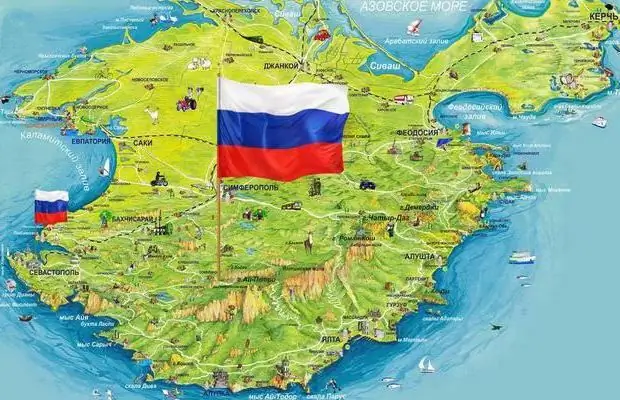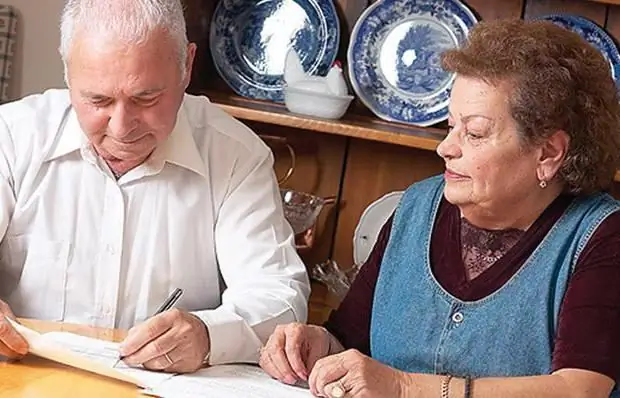2025 Author: Howard Calhoun | [email protected]. Last modified: 2025-01-24 13:10:41
Each banknote, be it a coin or a banknote, has its own "face", or rather, the front and back sides. However, it is sometimes very difficult for an ignorant person to understand where the front side of the bill is and where its back is. Of course, in order to pay for a product or service, such knowledge is not needed, but for some people this question has an important, sometimes even mystical meaning.
Where is the obverse
Avers - this is the name of the front side of a bill or coin, and this name comes from the French word avers or the Latin adversus, which means “facing the face.”

In general practice and special literature there is no consensus on how exactly to recognize the "face" of a banknote. Each state has the right to independently establish rules in this matter. However, there are some general guidelines for determining the obverse. So, on the front side, as a rule, are depicted:
- portrait of a ruler, president (current or former), head of state;
- coat of arms of the state or emblem of the country; sometimes it happens that the coats of arms are placed on both sides, then the obverse is the one on which the main symbol of the power is present, higher in rank or larger in size;
- legend displaying the name of the state, territory;
- name of issuing bank.
And if not a face
Sometimes, however, it happens that the front side of a banknote does not have any of the above features. How to be? In cases where the image placed on a banknote is neither a portrait nor a memorable place, the obverse is considered to be the side opposite the one on which the denomination of the banknote is placed, or the one where the serial number is indicated.

In the most difficult cases, you should refer to the national catalog of the country that issued the banknote. However, this rule applies more to coins, because they have a much smaller area, on which it can be difficult to place all the insignia.
Why the “face” of the ruble has changed
Russian banknotes also have obverse signs that fall under the general rules. Nevertheless, at different times, these distinctive features were not the same: portraits of tsars were almost always placed on the front side of Russian banknotes, and in Soviet times they were replaced by the portrait of the leader of the proletariat V. I. Lenin, present on banknotes of any denomination. However, after the 1991 coup, the authorities, and together withit and the political course of the state changed dramatically, and very soon a new currency was needed, on which the portrait of Vladimir Ilyich was quickly replaced with the image of the Kremlin, a symbol of state power, the main fortress of the country. From that time until now, the front side of the banknote of the Russian banknote has ceased to show portraits, so as not to depend on the political course of the state. Images of cities and cultural monuments are not ideologically motivated and will be relevant at any time.
Russian hundred
The front side of the 1993 100 ruble note was decorated with the image of the Senate Tower of the Moscow Kremlin and the Russian tricolor placed on the dome of the Senate. Actually, at that time, banknotes of any denomination had such an image on the obverse, but already in 1995 everything changed: new banknotes were issued in denominations of 1, 5, 10, 50, 100 and 500 thousand rubles. But the new "hundred" appeared a little later - on January 1, 1998.
The front side of the bill, the photo of which is placed below, has an image of a quadriga, a Roman two-wheeled chariot drawn by four horses. This bronze Apollo chariot adorns the portico of the Moscow Bolshoi Theatre.

Initially, the banknote of 100,000 rubles had the same image, but after the denomination of 1997, the horses “lost” exactly a thousand times and took their place of honor on the banknote of 100 rubles. In this form, a hundred still exist, but on October 30, 2013, a new one was published."Olympic" commemorative banknote of 100 rubles. It is symbolic that its release started exactly one hundred days before the opening of the Olympic Games. The front side of the 100 ruble note has an image of a snowboarder competing at the Olympics, and on the back there is a stylized firebird hovering over the Fisht Olympic Stadium. The total circulation of the "Olympic Hundred" amounted to 20 million copies, and some of them were released in a gift box.
Thousandth note
The obverse of the thousandth banknote of 1993 also had the image of the state flag on the Senate tower, and already in the 95th banknote was reissued again. The front side of the banknote of 1000 rubles, which entered circulation on September 29, 1995, perpetuates the sights of Vladivostok - the top of the rostral column in the form of the Manjur sailboat, which was installed at the entrance to the city in 1982. The second drawing on the obverse is the image of the seaport of Vladivostok, located in the famous Golden Horn Bay, which itself has a rich history. However, even in this form, the "thousand" did not last too long - a denomination broke out, and again new money was needed. On January 1, 2001, a new banknote with a face value of 1000 Russian rubles saw the light, its obverse was decorated with a monument to Grand Duke Yaroslav the Wise, erected in honor of the founder of the city by the inhabitants of Yaroslavl.

The second image on the front side of the banknote is the chapel of Our Lady of Kazan, with the Yaroslavl Kremlin in the background. In this form, the "thousandth" exists today. In spite ofthe fact that it was reissued twice, its appearance did not change, only degrees of protection were added.
Signs of authenticity
Each state that issues its own banknotes is simply obliged to take care of protecting their authenticity. Of course, it is no secret that counterfeiting banknotes and coins is a criminally punishable act, but, unfortunately, such knowledge is not able to stop counterfeiters who are thirsty for profit. Most often, the signs of authenticity are evenly distributed over the entire surface of the bill, but in some cases, most of them are given to the obverse.

For example, the signs of authenticity most often visible from the front are:
- moire pattern - a special area that changes its color and has visible rainbow stripes;
- kip-effect - a hidden image that can only be seen when looking at a bill at an acute angle;
- infrared tags - part of the image is covered with a special composition that tends to glow in infrared radiation;
- embossed inscriptions - made especially for visually impaired people;
- micro-perforation - denomination of banknote stuffed with small holes for visually impaired people;
- serial number located in a specific location;
- applying an image with color-changing paint.
Of course, there are other signs - watermarks, security fibers, magnetic marks, microtext, microprinting, protective metallic thread and so on, but they are most often present on the back or inthicker than the bill itself.
What kind of money the bank will not accept
Oddly enough, but in some cases a bill will not be accepted even if it is real. Banks withdraw from circulation (without reimbursement) the following banknotes:
- shabby, badly worn;
- withdrawn from circulation (at the end of the voluntary exchange period);
- parts of banknotes whose area is less than 55% of their original size;
- banknotes damaged by water, fire, chemicals, if less than 55% of the original area remains together with the destroyed areas;
- also do not accept banknotes if the reverse or front side of the bill does not have one of the two denominations, numbers, or if they are badly damaged: lack of a security thread, severe damage or replacement of the portrait, change in the denomination of the banknote in the corners;
- the same applies to torn, cut into several parts, glued banknotes, if one of the whole parts belongs to less than 55% of the area.
Money signs

Well, now you know where the front side of the bill is, so it's time to talk about the most popular and, they say, effective sign associated with the obverse. If you want to have money always and in large quantities, you should treat it with respect. There is an opinion that the money in the wallet should be located strictly obverse to its owner, and in a certain order - from larger to smaller, so that when opening the walletthe biggest bills were staring right in your face. And in no case should the money lie "upside down" - they can "take offense" and leave. Some people believe in omens, some don't, but it's easy to turn your money around, so what's stopping you from trying it - what if it works?
Recommended:
Which bank to take a mortgage? Which bank has the lowest mortgage rate?

Mortgage is offered by many banks on different terms. When choosing a bank in which this loan will be issued, it is important to take into account the interest rate and other parameters. Most often, citizens turn to large and well-known banking institutions that are participants in government programs
Criteria for small and medium businesses. Which business is considered small and which is medium

The state creates special conditions for the work of small and medium enterprises. They get fewer inspections, pay reduced taxes, and can keep more simplified accounting records. However, not every firm can be considered small, even if it occupies a small area. There are special criteria for small and medium-sized businesses, according to which they are determined by the tax office
Crimea: banknote of 100 rubles. Photo of the new hundred-ruble banknote

The article is dedicated to the new one hundred-ruble banknote issued in honor of the annexation of Crimea to the Russian Federation
Which loan is the most profitable and in which bank

The article describes the terms of lending to various banks. Considered requirements and interest rates
What is the funded and insurance part of the pension? The term for the transfer of the funded part of the pension. Which part of the pension is insurance and which is funded

In Russia, the pension reform has been in effect for quite a long time, a little over a decade. Despite this, many working citizens still cannot understand what the funded and insurance part of a pension is, and, consequently, what amount of security awaits them in old age. In order to understand this issue, you need to read the information presented in the article

